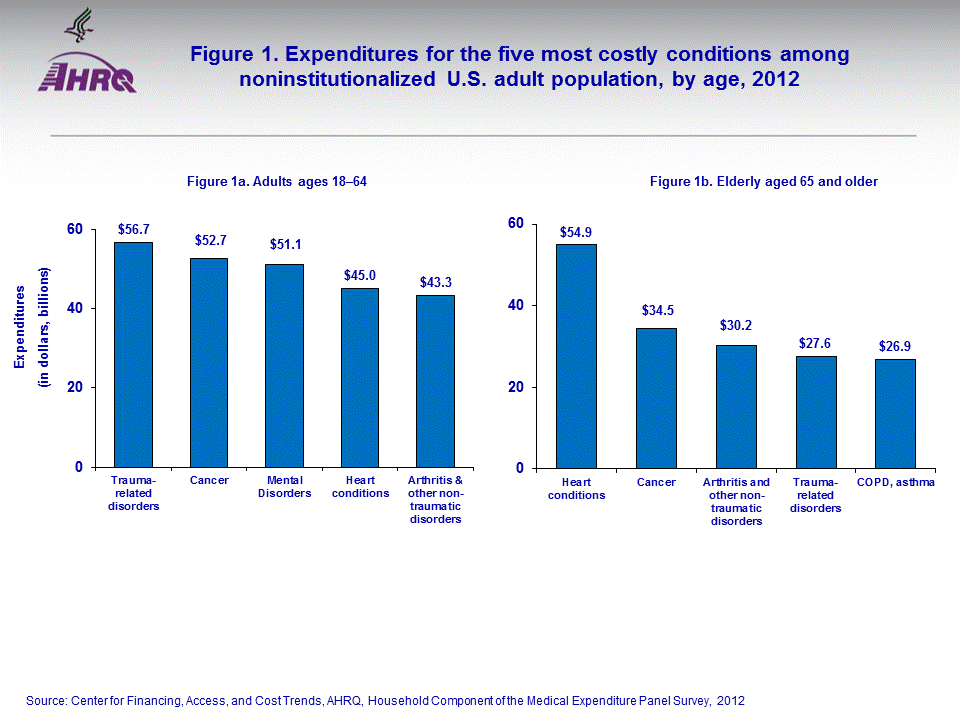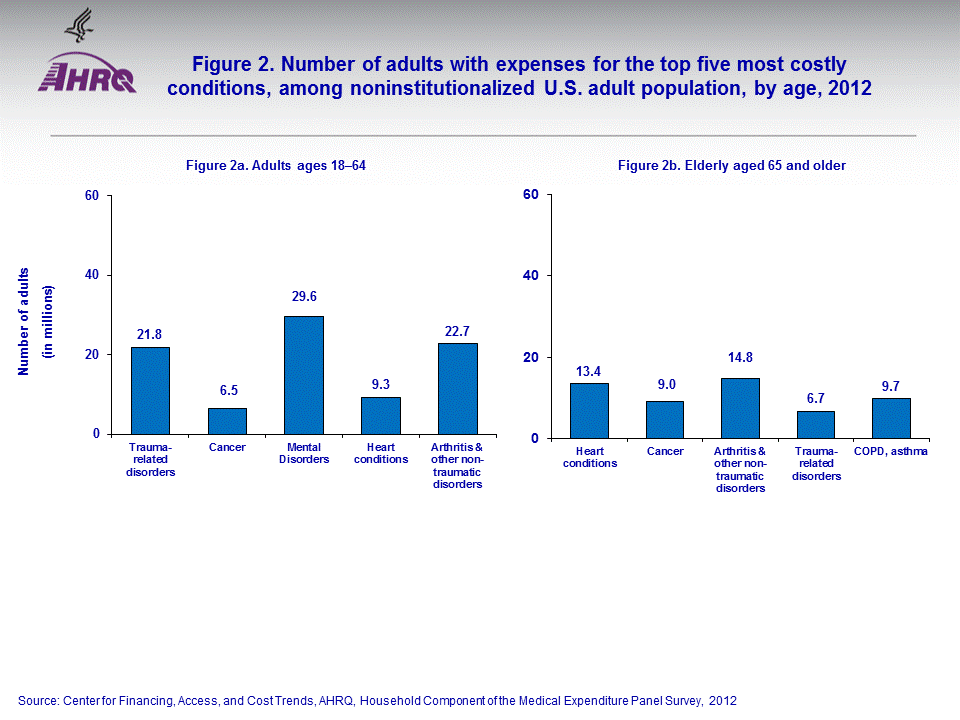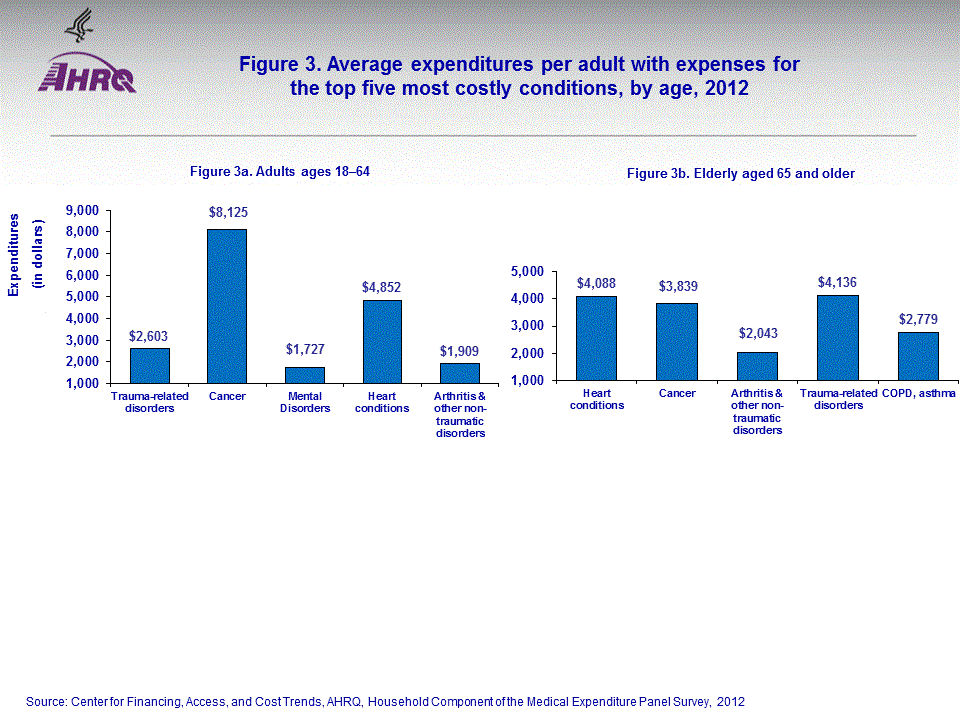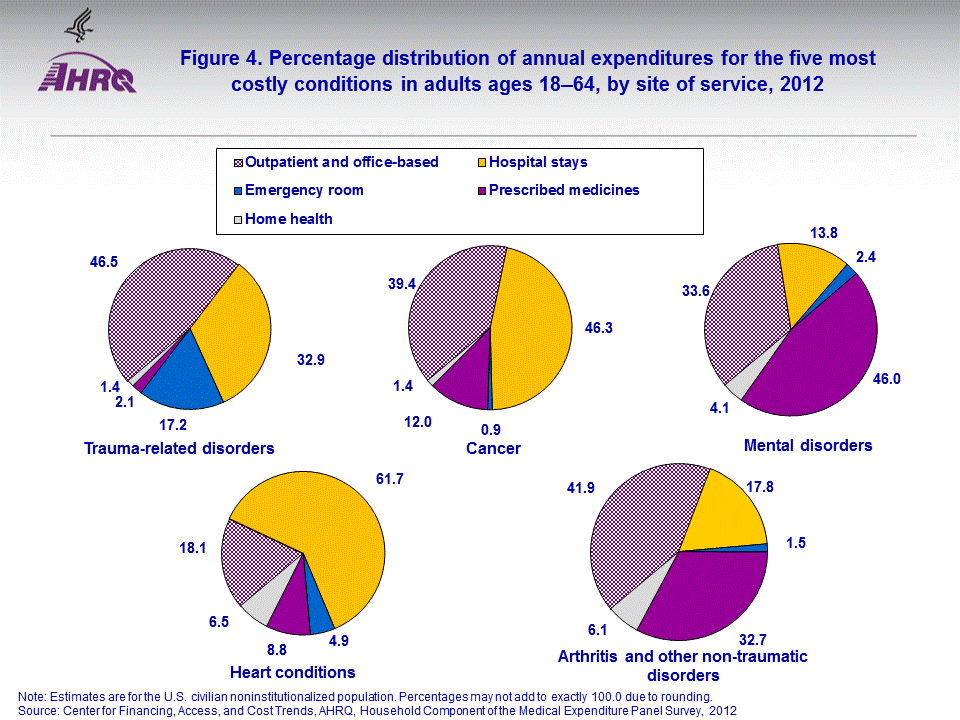
|
|
Font Size:
|
||||
|
|
|
|
||||
STATISTICAL BRIEF #471:
Top Five Most Costly Conditions among Adults Age 18 and Older, 2012: Estimates for the U.S. Civilian Noninstitutionalized Population
Highlights
- Four of the five most costly conditions were the same for adults ages 18-64 and the elderly in 2012.
- The five most costly conditions among adults ages 18-64 were trauma-related disorders, cancer, mental disorders, heart conditions, and arthritis and other non-traumatic joint disorders.
- For those over 65 years of age, heart conditions, cancer, arthritis and other non-traumatic joint disorders, trauma-related disorders, and chronic obstructive pulmonary disease (COPD) and asthma ranked highest in terms of direct medical spending in 2012.
- Among adults ages 18-64, the highest average per person expense was for cancer treatment ($8,125).
- Among the elderly, almost 15 million reported expenses for treatment of arthritis and other non-traumatic joint disorders.
Introduction
This Statistical Brief presents data from the Household Component of the Medical Expenditure Panel Survey (MEPS-HC) regarding medical expenditures associated with the five most costly conditions for adults age 18 and older. The estimates have been separately presented for individuals ages 18–64 and the elderly age 65 and older in 2012. The five most costly conditions among adults ages 18–64 were trauma-related disorders, cancer, mental disorders, heart conditions, and arthritis and other non-traumatic joint disorders. Among the elderly age 65 and older, the five most expensive conditions were heart conditions, cancer, arthritis and other non-traumatic joint disorders, trauma-related disorders, and chronic obstructive pulmonary disease (COPD) and asthma. The top five most expensive conditions were determined by totaling and ranking the expenses by condition for all medical care provided in 2012. Expenditures may be associated with more than one condition and are not unduplicated in the condition totals. Only differences between estimates that are statistically significant at the 0.05 level are discussed in the text.Findings
In 2012, cancer, heart conditions, arthritis and other non-traumatic joint disorders, and trauma-related disorders, were among the top five most costly conditions for both groups of adults. For adults ages 18–64, mental disorders were also in the top five. For the elderly age 65 and older, COPD and asthma was among the top five most expensive conditions.The highest condition-related expenditure total (figure 1) among adults ages 18–64 was for treatment of trauma-related disorders ($56.7 billion). The other four in the order of expenditures were cancer ($52.7 billion), mental disorders ($51.1 billion), heart conditions ($45.0 billion), and arthritis and other non-traumatic joint disorders ($43.3 billion). The highest expenditures among the elderly were for the treatment of heart conditions. A total of $54.9 billion was spent to treat heart conditions among those age 65 and older. Treatment of cancer ranked second ($34.5 billion), followed by arthritis and other non-traumatic joint disorders ($30.2 billion), trauma-related disorders ($27.6 billion), and COPD and asthma ($26.9 billion).
Among the most costly conditions, the largest number of persons ages 18–64 incurring expenses was treatment for mental disorders (29.6 million) (figure 2). This was followed by arthritis and other non-traumatic joint disorders (22.7 million) and trauma-related disorders (21.8 million). These were more than double the number of people with expenses for heart conditions (9.3 million) and more than three times the number of people with expenses for cancer (6.5 million).
Among the most costly conditions for persons age 65 and over, the number of persons with expenses was highest for arthritis and other non-traumatic joint disorders (14.8 million). This was more than double the number of people with expenses for trauma-related disorders (6.7 million). There were 13.4 million elderly incurring expenses for the treatment of heart conditions. Expenses for treatment of COPD and asthma were incurred by almost 10 (9.7) million elderly. Among the top five most expensive conditions, 9.0 million persons over the age of 65 incurred expenses for the treatment of cancer.
Almost 62 percent (61.7) of expenditures for the treatment of heart conditions among adults ages 18–64 was for hospital stays. For trauma-related disorders, hospital stays accounted for 32.9 percent of expenses (figure 4). Prescribed medicines accounted for 46 percent of expenses for mental disorders. Outpatient and office-based visits accounted for the largest percentage of expenses for trauma-related disorders (46.5 percent) among this age group. For heart conditions, only 18.1 percent of expenses were for outpatient and office-based visits among adults ages 18–64.
Among the elderly, more than half (50.8 percent) of expenditures for the treatment of heart conditions was for hospital stays and 11.1 percent of expenditures was for prescribed medicines (figure 5). For cancer, about a third of expenses (33.9 percent) was for hospital stays while more than 47 percent (47.7 percent) was for outpatient and office-based services. Hospital stays accounted for 41.1 percent of expenses for arthritis and other non-traumatic joint disorders while 14.6 percent was for prescribed medicines. With respect to trauma, more than half (53.2 percent) of expenses was for hospital stays and almost a quarter (24.3 percent) was for outpatient and office-based visits. For COPD and asthma, 43.4 percent of expenses were for inpatient hospital stays while a third (33.4 percent) was for prescribed medicines.
Data Source
The estimates shown in this Statistical Brief are based on data from the MEPS 2012 Full Year Consolidated Data File (HC-155), Medical Condition File (HC-154), Office-Based Medical Provider Visits File (HC-152G), Outpatient Visits File (HC-152F), Hospital Inpatient Stays File (HC-152D), Home Health File (HC-152H), Emergency Room Visits File (HC-152E), and Prescribed Medicines File (HC-152A).Definitions
ConditionsCondition data were collected from household respondents during each round as verbatim text and coded by professional coders using the International Classification of Diseases, Ninth Revision (ICD-9). ICD-9-CM condition codes were then aggregated into clinically meaningful categories that group similar conditions using the Clinical Classification System (CCS) software. Categories were collapsed when appropriate. The reported ICD-9-CM condition code values were mapped to the appropriate clinical classification category prior to being collapsed to 3-digit ICD-9-CM condition codes. The result is that every record which has an ICD-9-CM diagnosis code also has a clinical classification code.
Expenditures
Expenditures in MEPS are defined as payments from all sources for hospital inpatient care, ambulatory care provided in offices and hospital outpatient departments, care provided in emergency departments, paid care provided in the patient's home (home health), and the purchase of prescribed medications. Sources include direct payments from individuals, private insurance, Medicare, Medicaid, Workers' Compensation, and miscellaneous other sources. Payments for over-the-counter drugs are not included in MEPS total expenditures. Indirect payments not related to specific medical events, such as Medicaid Disproportionate Share and Medicare Direct Medical Education subsidies, are also excluded.
Expenditures were classified as being associated with a condition if a visit, stay, or medication purchase was cited as being related to the specific condition. Expenditures may be associated with more than one condition and are not unduplicated in the condition totals; summing over conditions would double-count some expenses. Total spending does not include amounts for other medical expenses, such as durable and nondurable supplies, medical equipment, eyeglasses, ambulance services, and dental expenses, because these items could not be linked to specific conditions.
About MEPS-HC
MEPS-HC is a nationally representative longitudinal survey that collects detailed information on health care utilization and expenditures, health insurance, and health status, as well as a wide variety of social, demographic, and economic characteristics for the U.S. civilian noninstitutionalized population. It is cosponsored by the Agency for Healthcare Research and Quality and the National Center for Health Statistics.References
For a detailed description of the MEPS-HC survey design, sample design, and methods used to minimize sources on non-sampling errors, see the following publications:Cohen, J. Design and Methods of the Medical Expenditure Panel Survey Household Component. MEPS Methodology Report No. 1. AHCPR Pub. No. 97-0026. Rockville, MD: Agency for Health Care Policy and Research, 1997. http://www.meps.ahrq.gov/mepsweb/data_files/publications/mr1/mr1.shtml
Cohen, S. Sample Design of the 1996 Medical Expenditure Panel Survey Household Component. MEPS Methodology Report No. 2. AHCPR Pub. No. 97-0027. Rockville, MD: Agency for Health Care Policy and Research, 1997. http://www.meps.ahrq.gov/mepsweb/data_files/publications/mr2/mr2.shtml
Cohen, S. Design Strategies and Innovations in the Medical Expenditure Panel Survey. Medical Care, July 2003: 41(7) Supplement: III-5–III-12.
Cohen, J. and Krauss, N. Spending and Service Use among People with the Fifteen Most Costly Medical Conditions, 1997. Health Affairs; 22(2):129–138, 2003.
Suggested Citation
Soni, A. Top Five Most Costly Conditions among Adults Age 18 and Older, 2012: Estimates for the U.S. Civilian Noninstitutionalized Adult Population. Statistical Brief #471. April 2015. Agency for Healthcare Research and Quality, Rockville, MD. http://www.meps.ahrq.gov/mepsweb/data_files/publications/st471/stat471.shtmlAHRQ welcomes questions and comments from readers of this publication who are interested in obtaining more information about access, cost, use, financing, and quality of health care in the United States. We also invite you to tell us how you are using this Statistical Brief and other MEPS data and tools and to share suggestions on how MEPS products might be enhanced to further meet your needs. Please email us at MEPSProjectDirector@ahrq.hhs.gov or send a letter to the address below:
Steven B. Cohen, PhD, Director
Center for Financing, Access, and Cost Trends
Agency for Healthcare Research and Quality
540 Gaither Road
Rockville, MD 20850
 |
||||||||||||||||||||||||||||||||||||||||||
|
||||||||||||||||||||||||||||||||||||||||||
|
|
||||||||||||||||||||||||||||||||||||||||||
 |
||||||||||||||||||||||||||||||||||||||||||
|
||||||||||||||||||||||||||||||||||||||||||
|
|
||||||||||||||||||||||||||||||||||||||||||
 |
||||||||||||||||||||||||||||||||||||||||||
|
||||||||||||||||||||||||||||||||||||||||||
|
|
||||||||||||||||||||||||||||||||||||||||||
 |
||||||||||||||||||||||||||||||||||||||||||
|
||||||||||||||||||||||||||||||||||||||||||
|
|
||||||||||||||||||||||||||||||||||||||||||
 |
||||||||||||||||||||||||||||||||||||||||||
|
||||||||||||||||||||||||||||||||||||||||||
|
|
||||||||||||||||||||||||||||||||||||||||||


